Last Updated on March 15, 2022
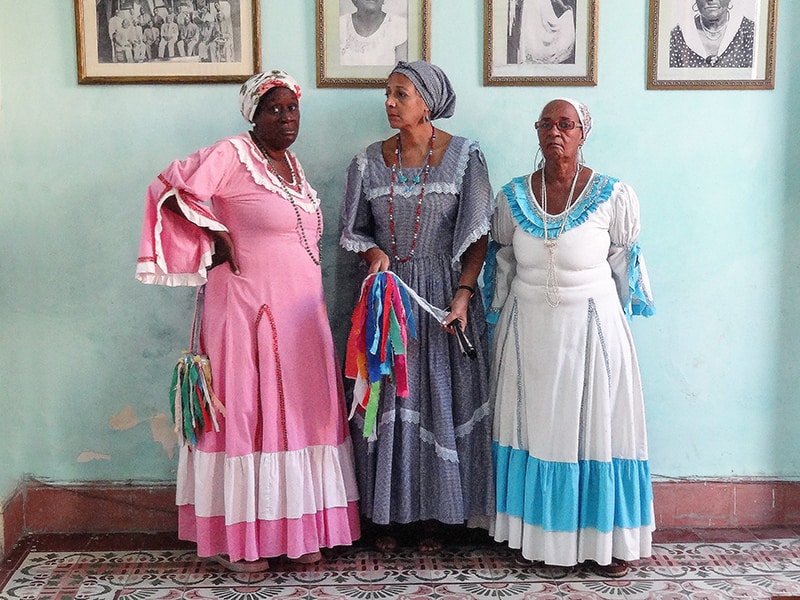
A trip to Cuba is still a fascinating experience for any traveler…
Estimated reading time: 10 minutes
By Jim Ferri
Liberalized rules now make traveling to Cuba legally easier than it has been for decades.
And interest in the island among Americans appears high, perhaps because for so long it has been “forbidden fruit.”
The rules that have made travel easier are known as “People-to-People” programs. They were launched in 1999 by President Clinton, then canceled by President George W. Bush and restored by President Obama. One can only guess what will happen in the future in this Cuban ping-pong game.
The programs are regulated by the Treasury Department for the simple reason that the law doesn’t prohibit travel to Cuba, it prohibits spending money in Cuba. Some politicians in Washington still condemn these trips as “outrageous” and as an “indoctrination of Americans by Castro government officials.”
I went on one of these trips just a few weeks ago and based on my experience I can tell you that nothing is further from the truth.
Just don’t expect the type of vacation where you can work on your tan on the beach or while sipping piña coladas poolside.
Traveling to Cuba Legally: A Different Type of Vacation
“People-to-People” programs, the basis of U.S. programs that allow traveling to Cuba legally, provide a taste of Cuban culture – especially in the arts, music and dance – and allow you to have incredible interactions with some of the friendliest people you’ll meet anywhere. They can be remarkable experiences.
On our trip we visited and spoke with a variety of people including fishermen who had their boats destroyed in Superstorm Sandy (before it barreled up the East Coast), dance troupes, local artists, even folks in a senior center who told me what it was like witnessing the revolution when they were children.
In addition to gaining access to such people, seeing and experiencing Cuba in one of these small groups makes the most sense for several reasons. The infrastructure of the country is in very poor shape, there are relatively few hotels, it can be very difficult to get around on your own and you can’t drink the water.
And if you’re an American add one other major challenge: Americans can’t use credit cards, traveler’s checks or ATMs while traveling in Cuba.
Our “People-to-People” Experience While on Our Legal Trip to Cuba
After we decided to travel to Cuba in a “People-to-People” program, my wife and I choose Grand Circle Foundation’s “Cuba: Music, Culture & the Roots of Revolution” tour.
We did so not only because of the company’s reputation for quality tours but also because of my previous experience with them (I had traveled with Grand Circle last year on a Great Rivers of Europe cruise – see River Cruising on the “Best in the World”.)
For me it makes sense to go with those who know the ropes and can enhance your travel experience. That’s even more important in a country like Cuba.
On any “People-to-People” tour, the basis of legal travels to Cuba, you must abide by the schedule and spend full days meeting and interacting with Cuban people, mainly through cultural and social organizations.
Grand Circle, as are all of the companies offering these experiences, is very strict about your participation in every activity. Allowing people to deviate from the prescribed program puts their license at risk with the Treasury Department.
But despite the schedule we didn’t feel hemmed in by the type of trip we were on. In fact, we did have a fair amount of freedom during those times when there were no programmed activities.
For example, although the tour was all-inclusive except for incidentals, there were three lunches and two dinners when we could dine out on our own at a place of our choice, or just wander about sightseeing and shopping. Several mornings I went out before a scheduled departure and wandered about the area near our hotels; another time I skipped an optional lunch and wandered the streets of Old Havana.
Firmly Wedged in the 1950s
When Fidel took over in 1959 more than 150,000 Fords, Cadillacs, Buicks, DeSotos, and other American makes were marooned in Cuba and for the past 50+ years industrious Cuban mechanics have kept them running. Walk around Havana and other cities and the sight of them makes you feel as though you’ve stepped back into another era.
So too is it with many of the old buildings and crumbling infrastructure you see all over the country. All of us on our legal tour of Cuba were greatly surprised by the deterioration of many buildings, especially in Havana, where sections of roofs had caved in and there were still people living or working in the building.
Another thing that made me feel as if I was in a time warp was the total lack of commercial advertising. The only “ads” one sees are about the revolution, which sporadically appear on walls of buildings all over the country. Along with the lack of any international magazines or newspapers anywhere you go, it all reminds you that the government stays firmly in control.
Also lacking are so many items we take for granted such as toilet paper, which in public facilities outside of the hotels is a luxury. It’s best to bring your own.
Many Other Surprises While Traveling to Cuba Legally
Because of the U.S. embargo most of our group really didn’t know what to expect in terms of how Cubans would treat us. But as it turned out wherever we went everyone was always delighted to meet and speak with us. Even when I took photos of people as we passed them in our bus most would smile and wave at me. Americans have been scarce in Cuba for so many years that people are delighted to meet you.
I was also surprised at how safe the country was. At no time anywhere in Cuba did we have concerns for our safety, likely because penalties for crimes against tourists are severe. But due to the country’s extreme poverty, common sense still dictated locking up our valuables and passports in our hotel safes.
It was this poverty that was the greatest surprise for many of us on our legal tour of Cuba, although most Cubans appeared to have a happy demeanor despite the hardships they’re enduring. Helping to counterweight poverty is Cuba’s free medical care and education system, the former considered one of the better in the world.
Nevertheless, the hardships are many. Cuba’s standard of living is much lower than other Western countries with rationing and frequent shortages of goods a fact of everyday life. The situation seemed worse in Havana, likely due to the city’s larger population, where it was not uncommon to be stopped and asked if we had any extra soap or shampoo. Everything seemed to be in short supply or out of economic reach, not surprising in a country where the average per capita wage is $20 a month.
This was the reason why prior to our trip Grand Circle suggested that we might want to bring inexpensive gifts to give to people we would meet on our trip. The list of suggestions ranged from nail polish for a dance company and powdered milk for a senior center, to sewing materials for a musical organization and crayons and paper for children.
A Little Shift Towards Capitalism
In speaking with many Cubans I found that many like Raul Castro, now firmly in charge since Fidel has passed away. The reason is that Raul has edged a little more towards capitalism by reinitiating licenses for private businesses. People can now own their own business and hire others and some people have set up beauty parlors, barbershops, locksmiths and other business in their homes.
From our perspective on our legal tour of Cuba, one of the best private business of late appear to be the paladares, private restaurants that people have set up in their homes as an alternative to the government-owned restaurants. Some of them have grown to being able to serve 20-50 people. As might be expected, they served the better meals we had while in Cuba, even though they still had limited menus.
Not a Foodie Destination
Despite the influx of paladares, Cuba is not a foodie destination by any stretch of the imagination. It’s probably the one thing that shocks travelers the most, whether you’re traveling to Cuba legally or have come in via some other route..
Rice and beans are staples of the diet with chicken, fish and pork supplying the protein (we were advised to avoid the beef since it was tough and tasteless). In fact, much of the food is bland and tasteless, even the bread. It was apparent why salt and spices were included in Grand Circle’s suggestions for gifts.
At breakfast one morning, in an effort to spice up his bland eggs, one of our fellow travelers asked for hot sauce. He was given a bottle, that label of which said “Mexican sauce,” but which turned out to be ketchup. At another meal several of us had difficulty in deciding whether we were eating chicken or fish.
Cuba’s cuisine calamity is a result of bad governmental farming practices and the soil being depleted of nutrients when, prior to its collapse, the Soviet Union was Cuba’s sugar daddy supplying ton after ton of fertilizer. Hopefully that will change in the future since farmers are now being allowed to grow produce to sell at public markets (instead of giving it all to the government, as was required in years past), yet another tiny step in the direction of free enterprise and communal gardens are being set up in some urban areas.
The lack of a few tasty meals, however, was inconsequential compared to the overall adventure of traveling about this island that time has forgotten, and meeting and speaking with some of the pleasantest people in the Caribbean.
If you go:
Grand Circle Foundation
347 Congress Street
Boston, MA 02210
Tel: (800) 221-2610
Overseas Adventure Travel

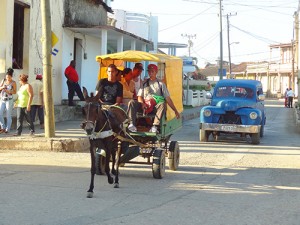
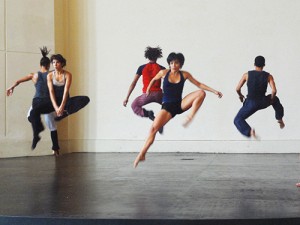
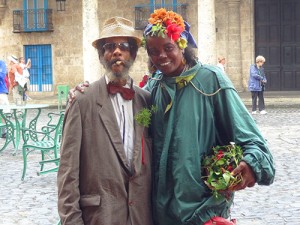
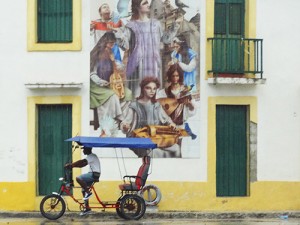
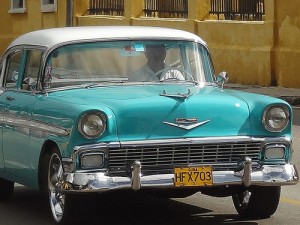
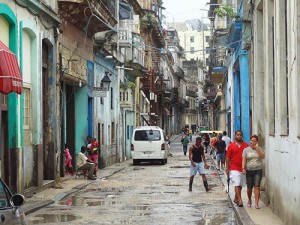
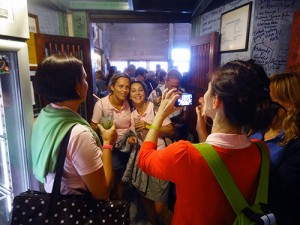
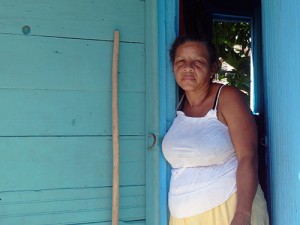
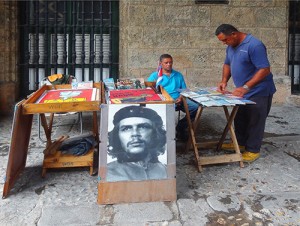
So glad you wrote about your experiences in Cuba! Rather than indoctrinating Americans, I believe these tourists will, over time, inspire and motivate Cubans to demand more.
We got a sense that it’s happening already. Raul Castro’s little shifts toward a more capitalistic society is happening for a reason.
Great job, Jim. I’d been thinking how I might attach the write up of this experience, but guess I now do not have to do it.
The pictures from the past couple of Foto Fridays have been great, too.
Hi to Marjorie. Winnie
Hi Winnie,
How great to hear from one of my fellow travelers! Thank you for the compliment and I’m glad you like our Foto Fridays. Did i ever tell you that my mother’s name (as well as a close cousin’s) was Wini?
Hi Jim,
Great job with the article. I am going to pass it on to my other friends that have bee interested in going to Cuba. Can’t wait for the next edition. Hi to Marjorie.
Sylvia
Hi Sylvia,
I’m glad you liked it!
Hi, Jim, and kudos from me as well. I think of all my fellow travelers on this journey often and miss you all! Happy New Year and my best to Marjorie too!
Keep those photos and stories coming! I look forward to the next edition on Cuba!
Carol
Thank you Carol. It was a good trip. And a Happy New Year to you as well.
I recently returned from a people to people trip with Friendly Planet. We had great food….lobster three times!!! Great pastries. Fresh fruits & juices, seafood ,and some great typical meals with lovely seasonings .
A bonus was a lot of organic produce from the many farms developed once the USSR left. The people have learned to work the land without pesticides and chemical fertilizers, and have a real awareness of environmental issues to protect their beautiful country.
I highly recommend these trips. We Americans need to be ambassadors for the Cuban people and remove some of the many stereotypes that exist here in the USA.
Hi Susan,
Thanks for your comment and I’m glad you visited Cuba also. I agree we need to be ambassadors on our return to the USA. We also had lobster a few times, although it did not have the same taste as our New England lobsters.I got sick one evening and missed a meal, which my wife told me was one of the better ones on the trip.